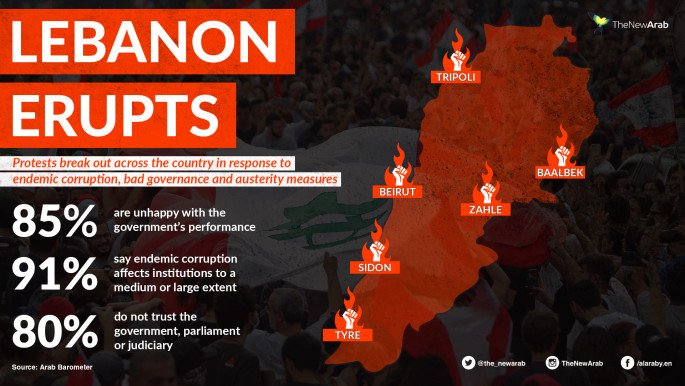Five things you need to know about the protests in Lebanon
The wave of protests, which has gripped the small Mediterranean country, has been seen as the biggest such movement in years.
The demonstrations have crippled the country and threatened the government of beleaguered Prime Minister Saad Hariri, whose reform plan was backed by government on Monday.
Here are the five things you need to know about the biggest protests Lebanon has seen in years.
1. This time it’s different
Although protests in Lebanon are frequent, this time it's really different.
The last major anti-government protest took place in 2015 with "You Stink" movement over the piling of garbage in the streets.
But that movement failed to connect with a critical mass outside of Beirut's urban class. The then interior-minister, Nouhad al-Machnouk, was able to mount a formidable crackdown that successfully defused the protests, with a combination of violence, legal warfare and literally erecting walls around the city centre.
 |
| Click here to enlarge |
But not this time. The protesters are unprecedented in scale and geographical distribution. They have achieved critical mass and truly paralysed the country, with a general strike shutting down most business and government departments on Monday.
The momentum seems to be growing, and the government, corrupt and caught by surprise, has not been able to meet the challenge so far.
2. It's not a social media bubble
The protests started after the minister of telecommunications - an out-of-touch multimillionaire - proposed a ridiculous tax on WhatsApp.
But the people of Lebanon are not rising up because of a social media app. And the people taking to the streets are not just a fleeting social media phenomenon that will burst soon.
The tax was only the straw that broke the camel’s back; people have run out of patience with the same political class that has ruled the country since 1990 and gave them nothing but terrible public services, unemployment, corruption, a brain drain, and the highest level of pollution on this side of the Mediterranean.
Twitter Post
|
3. Women are at the forefront
Women are not only participating in but are actually leading the protests.
This is nothing rare in the region despite all Western stereotypes about "submissive" and "powerless" Arab women. We have seen women at the forefront of uprisings in Sudan and Algeria.
But perhaps uniquely, women in Lebanon are in many ways second class citizens.
They cannot pass nationality to their children from foreign spouses. And the religious courts that dominate issues of personal status do not give them equal inheritance, marriage, or child custody rights.
Although the protests were triggered by economic concerns, a survey of slogans being chanted at the protests shows a lot of intersectionality emerging: Women’s rights, LGBT+ rights, refugee rights, and migrant worker rights are coming into the spotlight.
4. Sectarianism is not inevitable in Lebanon
One of the most infamous qualities Lebanon is known for is its sectarian system, which divides power and posts between its 18 sects based on the size of their demographics.
The Lebanese are known, deservedly or otherwise, for having a sectarian mindset by which they view the world and others.
But this could all be a construct imposed from the top as a divide and conquer tactic by the ruling elites that have dominated the country since its inception.
At least, the inter-confessional solidarity being shown by Sunnis, Shias, Christians and Druze seems to be genuine, meaning there is real hope of getting rid of these sectarian shackles.
Twitter Post
|
5. Half-measures by government will not appease protesters
In the first few days of the protests, the response of the country’s leaders, President Michel Aoun, PM Hariri, FM Gibran Bassil and Speaker of parliament Nabih Berri seems to have been based on "ignore them and they'll go away".
As numbers swelled, they started to adjust the tenor of their speeches, and on Monday Aoun said accusing the entire political class of corruption was "unfair".
Hariri for his part offered a "reform package" that would cut officials salaries by 50 percent and impose taxes on the banking sector rather than the working class.
However, these measures are tone deaf and do not address the heart of the crisis.
The people are fed up with the entire political class, and another 'white paper' with more 'committees' formed will do little to appease them without heads rolling, at least metaphorically.
What will happen next?
So far, the protests have been an expression of anger and frustration, but no specific demands and policy direction have emerged beyond asking for the entire political class to step down.
If momentum is maintained in the next days and weeks, we’ll see the emergence of both clear demands and some form of representatives who can negotiate on behalf of the protesters, a direction similar to the so-far successful protests in Sudan and Algeria.
The protest movement will have to answer several tough questions as well. What to do about the powerful Hezbollah, which enables the current system to survive? Will heading to early polls provide a solution or will it reproduce the same problems? Can the protests really succeed in radically altering the country’s rentier, unequal economic model, which is the root of all evil in Lebanon?
No one knows the answers to these questions yet, but one thing is clear: History is being made in Lebanon, right now.
Follow us on Twitter: @The_NewArab





 Follow the Middle East's top stories in English at The New Arab on Google News
Follow the Middle East's top stories in English at The New Arab on Google News


